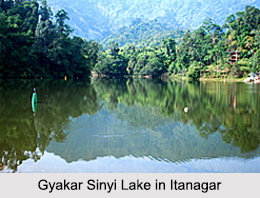 Itanagar, the capital of India`s largest North Eastern state, Arunachal Pradesh, is surrounded by snow covered mountains. Itanagar is an important transport hub of the state. It is often known for the tribal drink, Apong, which is made out of rice. This is made by the Nyishi tribal people. One can identify them by their massive knot of hair rolled into a bun over their forehead. Residence of the Governor and Buddhist monasteries are located atop the mountain peaks of this state. It is considered as a major hill station of north east and one of the most celebrated places in Arunachal Pradesh for housing several Buddhist shrines.
Itanagar, the capital of India`s largest North Eastern state, Arunachal Pradesh, is surrounded by snow covered mountains. Itanagar is an important transport hub of the state. It is often known for the tribal drink, Apong, which is made out of rice. This is made by the Nyishi tribal people. One can identify them by their massive knot of hair rolled into a bun over their forehead. Residence of the Governor and Buddhist monasteries are located atop the mountain peaks of this state. It is considered as a major hill station of north east and one of the most celebrated places in Arunachal Pradesh for housing several Buddhist shrines.
History of Itanagar
It is popularly believed that the ancient forefathers who migrated to the land of Arunachal Pradesh and Itanagar were of tribal origin who resided in the jungles of the region. Early writings of Arunachal Pradesh can be traced even in Mahabharata, Ramayan and Vedic Period. According to local legends originally the place had Hinduism as a major religion which later on included Buddhism as well. Buddhism was carried over by building Buddhist temple that was worshipped by Padma Sambhava. As such the history of Itanagar frames the cultural background of the people of Itanagar which is often reflected in festivals and other social occasions of Itanagar.
Geography of Itanagar
Itanagar is located at 27degree 06 minutes N to 93 degree 37 minutes E. Located at an average elevation of 440 meters or 1443 feet.
 Demography of Itanagar
Demography of Itanagar
According to the 2011 India census, Itanagar had a population of 59,490. Males constitute 53 percent of the population and females 47 percent. Itanagar has an average literacy rate of 66.95 percent. Male literacy rate is 73.69 percent, and female literacy rate is 59.57 percent. 15 percent of the population is under 6 years of age here. The place has common tribes who inhabit the area from prehistoric times. The major tribes are the Nyishis, Adis, Galos, Apatanis and the Miri`s etc.
Culture of Itanagar
People of Itanagar are largely Buddhist; there are communities who are either warriors or scholars or simply cultivators. Itanagar is surrounded with a number of legendary temples which celebrate numerous festivals. Among them, the most prominent ones are the festivals of Monpas, Reh and a number of Buddhist festivals and some Hindu rituals. Dressed in ceremonial robes the people of Itanagar celebrate each occasion with a lot of participation.
Education in Itanagar
Itanagar is moderately educated. It has some important educational centers like Donyi-Polo Vidya Bhawan a Premier Publics School, North-Eastern Regional Institute of Science and Technology (Nirjuli) - an engineering institute providing innovative way of education, Arunachal University (Doimukh) and Government Piggery and Poultry Farm (Nirjuli), Indira Gandhi Park etc.
 Tourism in Itanagar
Tourism in Itanagar
Itanagar is one of the most picturesque cities of Arunachal Pradesh. It has several popular tourist spots which are Buddhist Temple, Gyakar Sinyi Lake, Polo Park, Ita Fort, Noksaparbat, and Jawaharlal Nehru State Museum etc.
Ita Fort: Ita Fort in Itanagar is one of the popular historical sites of Arunachal Pradesh. The name of the fort means the "Fort of Bricks". The fort was built during the 14th or 15th century by the kings of Chutia Dynasty. Archaeological things found from the fort are exhibited in the Jawaharlal Nehru Museum.
Jawaharlal Nehru State Museum: Things of 14th or 15th century found from the Ita Fort are exhibited in this museum. Apart from that, it also showcases the collection of arts and crafts, jewellery, textiles and a variety of tribal headgear of the tribal people of Arunachal Pradesh.
Gyakar Sinyi Lake: Gyakar Sinyi Lake, also known as Ganga Lake, is a natural lake which means confined lake in Nyishi dialect. The lake is surrounded by hard rock. Vegetation, Orchid on trees, boating facility make this lake a popular picnic spot as well.
Visiting Information to Arunachal Pradesh
Regular helicopter service is available from Guwahati to Naharlagun. Nearest railway station is also at Naharlagun, which is 15 km away from Itanagar. From Naharlagun station one has to reach Itanagar by car or bus. National Highway 415 is connected to Itanagar with Assam and other parts of the country.



















